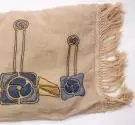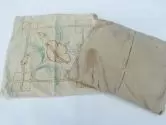To Clean Or Not To Clean
 From the Desk of Dianne Ayres, textilestudio.com
From the Desk of Dianne Ayres, textilestudio.com
Cleaning antique textiles provides many quandaries, among them — “What is that stain?”, “Can it be removed?”, “Are the colors of the design and fabric permanent?” and “Does the value of the piece warrant professional textile conservation?” Since textiles can vary so much, it is best to start with the last question and work backwards.
If the textile is very special, such as an embroidery by Newcomb College, Deerfield or Craftsman Workshops, you suspect it is highly valuable, or you personally greatly value it as an heirloom then the best option is to call in a professional. The reason being that, often the colors in textiles from the turn of the century were not permanent and standard cleaning methods would very likely ruin the piece or greatly reduce its value. A textile conservator can give you a good prognosis for the outcome of cleaning and will use very sophisticated techniques and equipment to get the best result possible for your item. To find a textile conservator, check with your local museum or the American Institute for Conservation (conservation-us.org).
For the vast majority of textiles, professional conservation is not warranted, so the question remains of what to do. First, try simply brushing the surface with a soft bristle brush, such as a clean cosmetic brush. This helps remove surface dirt, dust and possibly some oils. Be careful not to snag any embroidery or lace.
If you wish to consider washing your textile, here are some basic considerations.
– Test the permanence of the fiber colors. Test each color of embroidery thread and the fabric itself. If there is a loose end on the back or the edge that you can snip off, place this in a wet cotton ball. If the color has not bled out after 10 minutes, repeat the test using a soapy cotton ball. If still no bleeding, then it MIGHT be safe to wash the piece. No guarantees here as textiles can develop a mind of their own and do some surprising things.
– Shrinkage is also a concern, the fabric and embroidered or appliquéd areas can shrink in different ways and leave you with a misshapen piece which may or may not be remedied by blocking.
– If the item has any painted areas, such as stenciling, this most likely is not permanent and unless there is a hidden area that you can do the cotton ball test on, then cleaning is not advised.
– Spot cleaning is generally not a good idea as it will often leave a larger water stain which is even more noticeable.
– Textiles become brittle with age, even some fabrics which appear sturdy can disintegrate when washed.
Being aware of all of these caveats, if you do decide to wash the textile and are willing to risk your textile to the whims of water, here are some suggestions:
– Ideally, use a basin or tub large enough so that the textile can lay flat without folding or bunching.
– Use cool or lukewarm water — never hot.
– Use a mild soap — not a detergent. Orvus paste, available from many sources online, is the best choice.
– Rinse completely and gently. If your water contains minerals, use distilled water for the final rinse to avoid rust stains from forming.
– Never lift a wet textile by picking it up by small areas as the weight of the water can often cause tears if the item is lifted without support. Instead, place a net underneath your textile and lift the netting. Or, at minimum, place your hands underneath with your fingers spread out to distribute the weight of the wet textile.
– Never twist or wring an antique textile. Transfer it to a clean towel and roll it loosely to help absorb excess water.
– Lay it flat to dry on a sweater drying screen so that air can circulate around.
– If you need to press the textile, lay it on a thick soft cloth face down and iron on the wrong side.
And lastly, some textiles simply cannot be cleaned. Or even if they are cleaned, the stains may persist. These should be considered a part of the textile’s history and remind us that textiles are an essential part of creating a comfortable, cheerful, friendly, lived-in Arts & Crafts home.
Many thanks to our guest columnist, Dianne Ayres! Please visit her website (textilestudio.com) if you have any additional questions or wish to add some Arts and Crafts textiles to your collection!

